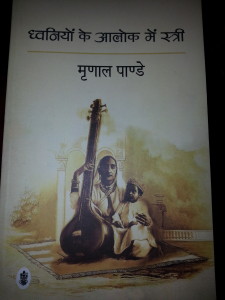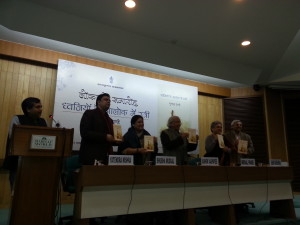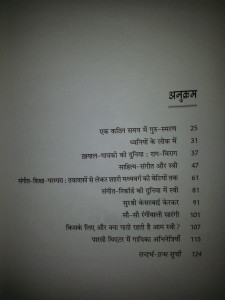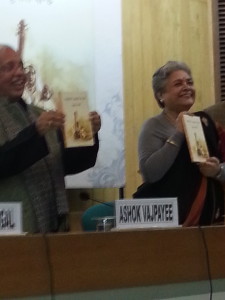“The Free Voice: On Democracy, Culture and the Nation” by Ravish Kumar
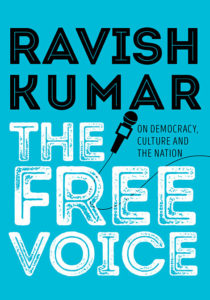 The Free Voice: On Democracy, Culture and the Nation by renowned journalist Ravish Kumar is a collection of his essays on the state of the nation and he stresses the importance of how citizens of a functioning democracy must use every space available to them to speak out. Otherwise the new normal is that “the socialization of fear is complete. To be afraid is to be civilised in this new democracy”. Every single essay deserves to be read over and over again but there is a particularly chilling one which he wrote called “Wherever a Mob Gathers Is Hitler’s Germany” drawing parallels between the propoganda by right wing fundamentalists in Nazi Germany and conservative politicians of today, many of whom have a history of being responsibile for pogroms. “Any other narrative was allowed no existence at all. People were steadily moulded by the propoganda and they did not realize they had been transformed into a weapon. Propaganda has only one purpose — the construction of a mob. It is the mob which carries out the killings and blood splatters the clothes of those who make up the mob. the government and the leaders all appear blameless. No one questions the role of propaganda in bringing mobs together.”
The Free Voice: On Democracy, Culture and the Nation by renowned journalist Ravish Kumar is a collection of his essays on the state of the nation and he stresses the importance of how citizens of a functioning democracy must use every space available to them to speak out. Otherwise the new normal is that “the socialization of fear is complete. To be afraid is to be civilised in this new democracy”. Every single essay deserves to be read over and over again but there is a particularly chilling one which he wrote called “Wherever a Mob Gathers Is Hitler’s Germany” drawing parallels between the propoganda by right wing fundamentalists in Nazi Germany and conservative politicians of today, many of whom have a history of being responsibile for pogroms. “Any other narrative was allowed no existence at all. People were steadily moulded by the propoganda and they did not realize they had been transformed into a weapon. Propaganda has only one purpose — the construction of a mob. It is the mob which carries out the killings and blood splatters the clothes of those who make up the mob. the government and the leaders all appear blameless. No one questions the role of propaganda in bringing mobs together.”
These essays have been translated from Hindi by Chitra Padmanabhan, Anurag Basnet and Ravi Singh. These essays are going to be discussed for a long time to come. Ideally the book should be released with the audio version of these essays being narrated in Hindi by Ravish Kumar. Or release the audio clips online.
The following is an extract from “Being the People” being published here with permission. It is an essay that encourages people to be active citizens of a democracy if they wish to protect their rights. “It is time to stop looking for all sorts of excuses for our ‘lack of strength’, or powerlessness, and face teh reality that this enfeeblement of citizens has come about because we have abandoned dissent and turned to supplication.”
*****
Now once again there is a move to drag history-writing back to the chronicles of kings and queens. It is reckless myth-making, fuelled by the idea of retribution—the ‘faithful’, the ‘true Hindus’, will avenge the deeds, real and imagined, of those who are no longer in our midst. The idea of vengeance persists even though those who exist in the present have nothing to do with that history and are not responsible for any of it.
Through these narratives of the new national curriculum, young hearts are being filled with the flames of hatred; they are being transformed into human bombs walking in our midst. Communalism turns human beings into bombs—we will see this change not just in our neighbour’s child but also in our own. When a youth filled with pure hatred chances upon an ordinary quarrel between two individuals who happen to be from different faiths, he can only see the incident with a communal eye and explode, human bomb that he is. He becomes a participant in the act of killing; part of the crowd that kills a Pehlu Khan or Muhammad Akhlaq or Junaid Khan, knowing he will never be punished by the powers that be. This is the kind of human bomb we have in our midst today. We are no longer a weak-hearted people; now that 1,200 years of slavery and sixty years of sickularism and bad governance are behind us, we have produced our own Jihadi John, who hacks and burns a man to death and releases the video on the internet.
As these human bombs increase in numbers in any society or nation, it is not the state that stands to lose but all of us—our status and power as citizens will correspondingly shrink. When we watch television images of a person beaten to pulp by a crowd—he may be of any religion—the moment at which the victim is overpowered by the crowd leaves us shaken and afraid even though we are watching the news in the safety of our home. We are wary of sharing our feelings on Facebook and hesitate to step out of the house at certain times. We feel intimidated and our civil rights as citizens get eroded.
Our minds are being filled with hatred not only for the sole purpose of perpetuating the hold of a particular party or ideology on power but to ensure the complete decimation of the power that comes with being the citizens of a democracy. I earnestly urge you to keep your child safe from the ill-effects of the new national curriculum on social media and prime-time television, and keep yourself out of its reach as well. The national curriculum is virulent in its theme, and unrelenting. It has a predictable pattern—wherever there is an election, it makes its presence felt. All of us need to have the self-confidence that is part of the consciousness of being the people of a strong civilization, a rich and diverse culture. Just as justice and injustice are part of our present, so it was in the past. We need to learn to deal with it. We should know how to negotiate history. But these debates are pushing us to the farthest extremes; consequently, we are moving inexorably towards communalization—an ever-widening gulf of mistrust with regard to a particular community.
In schools all over Germany, children are educated on how to deal with the blot on their past because of Hitler and his Nazi regime, one of the most evil in all history. This is a stigma that cannot be removed either by tearing out or burning those pages of history, or by running away and hiding from it. I once asked a German journalist if they were overcome by a sense of guilt.
Mentioning that politicians in my country didn’t think twice about casually branding anybody as Hitler, I asked her if that were so in Germany as well. She replied, ‘We are very careful about how we bring Hitler’s name into any debate; only an individual who loses the ability to offer a reasoned and human argument is thought to possess a Hitlerian streak.’
She recalled that around the time the film Schindler’s List, set in Nazi Germany, was released, their teacher spoke to them. This is what the teacher said: ‘The film dwells on the darkest chapter in the history of our nation. Yes, it did happen, but we are not to blame—neither your father nor mine. We ought to be ashamed of this dark chapter of our history and we are, but when we watch the film we shall not be wracked by guilt or anger. Rather, we shall experience a sense of self-confidence that we are no longer trapped in that time; we have come a long way from that juncture and are living in a new age.’
We in India have not educated our citizens on ways to negotiate history. On the contrary, the narrative that is being created as a ‘tradition’, especially through our television channels, is one of inhumanity. Perhaps many will dismiss these words of caution, calling me alarmist. But there will come a time when we will recall these words in distress—if not for ourselves, then for our children, for no one among us wants to see our child pick up a sword to kill a neighbour. Our child may well be saved by the party he owes allegiance to, but we will not get a moment’s sleep knowing that our child is a murderer.
When Pehlu Khan was lynched in Alwar, there was little reaction on the part of society and none from the government. When Junaid Khan was killed on a crowded railway platform, no one came to his aid, and later there were no witnesses, everyone claimed to have been somewhere else, or busy with something so consuming that the cries of a man being butchered and his brothers did not reach them. Examine the damage that was done: two men died, in terror and unimaginable pain. If that does not matter to us, do we think of those who killed and will not be punished? How many were they? Eight? Ten? Twenty? We don’t know, we make no effort to know. Those men, they must have gone home after they killed. What food did they eat that evening? Who cooked it for them? How many greeted them in their mohallas the next morning? There are eight, ten, twenty murderers roaming freely in our society. In another year there may be eight hundred, or twenty thousand. Murder will be normal then. It will be like any other job—like weaving a beautiful carpet or sari, driving a car, tending a garden, writing software or nursing the sick. Killers will emerge among us, kill and come back home after a day’s work. They might be our children, our siblings, our husbands or wives. Have we agreed to this? When we cast our vote, was this the world we chose?
Let us not turn away from what is happening. The future is grim. Due to the ongoing poisonous Hindu-Muslim discourse, human bombs are being prepared in large numbers, out of hatred among the Hindus and out of sheer fear among the Muslims. Our society is poised to reach its nadir. In places with dense populations, communalism will incubate more human bombs.
Ravish Kumar The Free Voice: On Democracy, Culture and the Nation Speaking Tiger, New Delhi, 2018. Hb. pp. 180 Rs.499
11 March 2018


